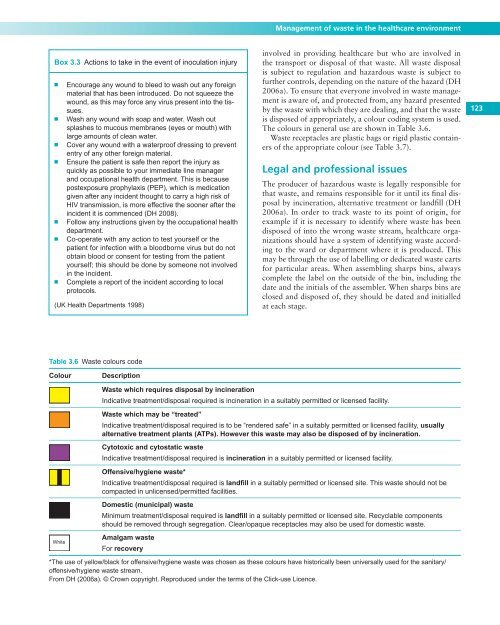Infection prevention and control - Royal Marsden Manual of Clinical ...
Infection prevention and control - Royal Marsden Manual of Clinical ...
Infection prevention and control - Royal Marsden Manual of Clinical ...
You also want an ePaper? Increase the reach of your titles
YUMPU automatically turns print PDFs into web optimized ePapers that Google loves.
Box 3.3 Actions to take in the event <strong>of</strong> inoculation injury<br />
■ Encourage any wound to bleed to wash out any foreign<br />
material that has been introduced. Do not squeeze the<br />
wound, as this may force any virus present into the tissues.<br />
■ Wash any wound with soap <strong>and</strong> water. Wash out<br />
splashes to mucous membranes (eyes or mouth) with<br />
large amounts <strong>of</strong> clean water.<br />
■ Cover any wound with a waterpro<strong>of</strong> dressing to prevent<br />
entry <strong>of</strong> any other foreign material.<br />
■ Ensure the patient is safe then report the injury as<br />
quickly as possible to your immediate line manager<br />
<strong>and</strong> occupational health department. This is because<br />
postexposure prophylaxis (PEP), which is medication<br />
given after any incident thought to carry a high risk <strong>of</strong><br />
HIV transmission, is more effective the sooner after the<br />
incident it is commenced ( DH 2008 ).<br />
■ Follow any instructions given by the occupational health<br />
department.<br />
■ Co-operate with any action to test yourself or the<br />
patient for infection with a bloodborne virus but do not<br />
obtain blood or consent for testing from the patient<br />
yourself; this should be done by someone not involved<br />
in the incident.<br />
■ Complete a report <strong>of</strong> the incident according to local<br />
protocols.<br />
( UK Health Departments 1998 )<br />
Table 3.6 Waste colours code<br />
Colour Description<br />
White<br />
Management <strong>of</strong> waste in the healthcare environment<br />
involved in providing healthcare but who are involved in<br />
the transport or disposal <strong>of</strong> that waste. All waste disposal<br />
is subject to regulation <strong>and</strong> hazardous waste is subject to<br />
further <strong>control</strong>s, depending on the nature <strong>of</strong> the hazard ( DH<br />
2006a ). To ensure that everyone involved in waste management<br />
is aware <strong>of</strong>, <strong>and</strong> protected from, any hazard presented<br />
by the waste with which they are dealing, <strong>and</strong> that the waste<br />
is disposed <strong>of</strong> appropriately, a colour coding system is used.<br />
The colours in general use are shown in Table 3.6 .<br />
Waste receptacles are plastic bags or rigid plastic containers<br />
<strong>of</strong> the appropriate colour (see Table 3.7 ).<br />
Legal <strong>and</strong> pr<strong>of</strong>essional issues<br />
The producer <strong>of</strong> hazardous waste is legally responsible for<br />
that waste, <strong>and</strong> remains responsible for it until its fi nal disposal<br />
by incineration, alternative treatment or l<strong>and</strong>fi ll ( DH<br />
2006a ). In order to track waste to its point <strong>of</strong> origin, for<br />
example if it is necessary to identify where waste has been<br />
disposed <strong>of</strong> into the wrong waste stream, healthcare organizations<br />
should have a system <strong>of</strong> identifying waste according<br />
to the ward or department where it is produced. This<br />
may be through the use <strong>of</strong> labelling or dedicated waste carts<br />
for particular areas. When assembling sharps bins, always<br />
complete the label on the outside <strong>of</strong> the bin, including the<br />
date <strong>and</strong> the initials <strong>of</strong> the assembler. When sharps bins are<br />
closed <strong>and</strong> disposed <strong>of</strong>, they should be dated <strong>and</strong> initialled<br />
at each stage.<br />
Waste which requires disposal by incineration<br />
Indicative treatment/disposal required is incineration in a suitably permitted or licensed facility.<br />
Waste which may be “treated”<br />
Indicative treatment/disposal required is to be “rendered safe” in a suitably permitted or licensed facility, usually<br />
alternative treatment plants (ATPs). However this waste may also be disposed <strong>of</strong> by incineration.<br />
Cytotoxic <strong>and</strong> cytostatic waste<br />
Indicative treatment/disposal required is incineration in a suitably permitted or licensed facility.<br />
Offensive/hygiene waste*<br />
Indicative treatment/disposal required is l<strong>and</strong>fi ll in a suitably permitted or licensed site. This waste should not be<br />
compacted in unlicensed/permitted facilities.<br />
Domestic (municipal) waste<br />
Minimum treatment/disposal required is l<strong>and</strong>fi ll in a suitably permitted or licensed site. Recyclable components<br />
should be removed through segregation. Clear/opaque receptacles may also be used for domestic waste.<br />
Amalgam waste<br />
For recovery<br />
*The use <strong>of</strong> yellow/black for <strong>of</strong>fensive/hygiene waste was chosen as these colours have historically been universally used for the sanitary/<br />
<strong>of</strong>fensive/hygiene waste stream.<br />
From DH (2006a ). © Crown copyright. Reproduced under the terms <strong>of</strong> the Click-use Licence.<br />
123


